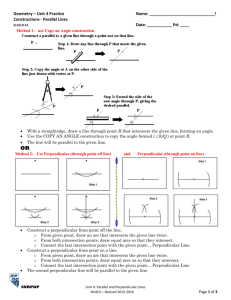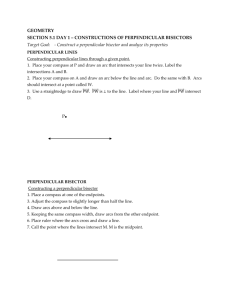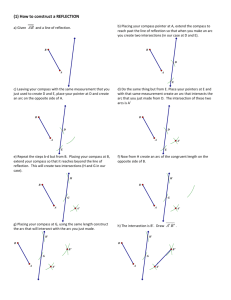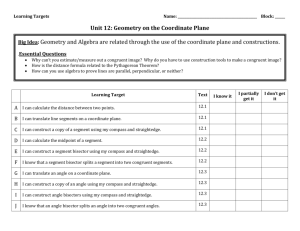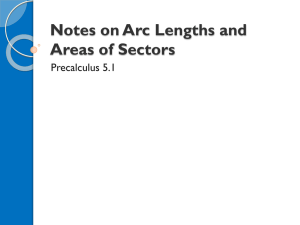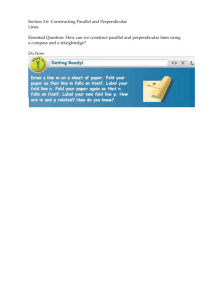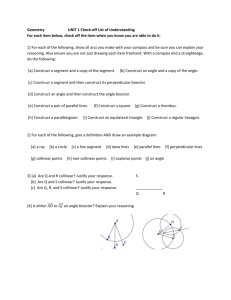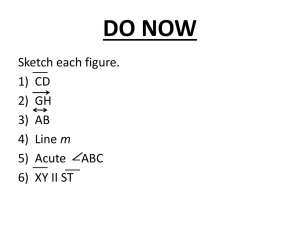CONCEPT 1 -- Make formal geometric constructions with a variety of
advertisement
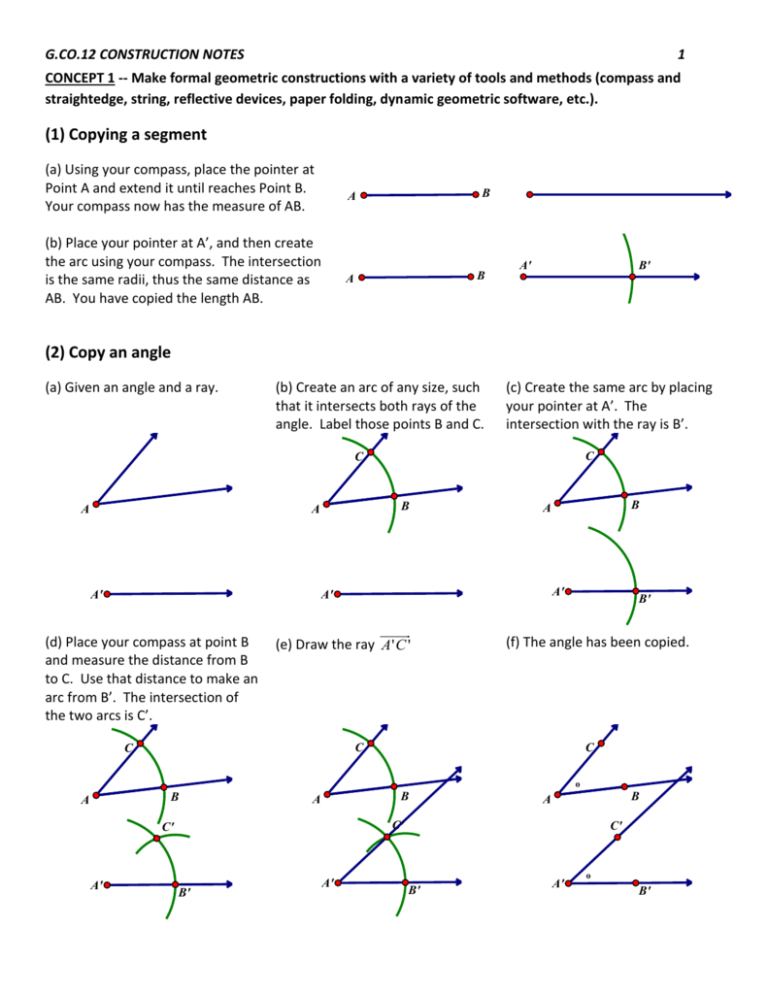
G.CO.12 CONSTRUCTION NOTES 1 CONCEPT 1 -- Make formal geometric constructions with a variety of tools and methods (compass and straightedge, string, reflective devices, paper folding, dynamic geometric software, etc.). (1) Copying a segment (a) Using your compass, place the pointer at Point A and extend it until reaches Point B. Your compass now has the measure of AB. B A (b) Place your pointer at A’, and then create the arc using your compass. The intersection is the same radii, thus the same distance as AB. You have copied the length AB. B A A' B' (2) Copy an angle (a) Given an angle and a ray. (b) Create an arc of any size, such that it intersects both rays of the angle. Label those points B and C. (c) Create the same arc by placing your pointer at A’. The intersection with the ray is B’. C C A B A A' A' A' (d) Place your compass at point B and measure the distance from B to C. Use that distance to make an arc from B’. The intersection of the two arcs is C’. B A (e) Draw the ray A ' C ' B' (f) The angle has been copied. C C C o B A B A C' C' A' B A B' A' C' B' A' o B' G.CO.12 CONSTRUCTION NOTES 2 (3) Bisect a segment (b) Place your pointer at A, extend your compass so that the distance exceeds half way. Create an arc. (a) Given AB (c) Without changing your compass measurement, place your point at B and create the same arc. The two arcs will intersect. Label those points C and D. C A A A B B B D (d) Place your straightedge on the paper so that it forms CD . The intersection of CD and AB is the bisector of AB . (e) I labeled it M, because it is the midpoint of AB . C A A M M B B D (4) Bisect an angle (a) Given an angle. (b) Create an arc of any size, such that it intersects both rays of the angle. Label those points B and C. (c) Leaving the compass the same measurement, place your pointer on point B and create an arc in the interior of the angle. C C A A A B (d) Do the same as step (c) but placing your pointer at point C. Label the intersection D. (e) Create AD . AD is the angle bisector. B (f) AD is the angle bisector. G.CO.12 CONSTRUCTION NOTES 3 C C C D D A D A A B o o B B (5) Construct the perpendicular bisector of a line segment (b) Place your pointer at A, extend your compass so that the distance exceeds half way. Create an arc. (a) Given AB (c) Without changing your compass measurement, place your point at B and create the same arc. The two arcs will intersect. Label those points C and D. A C B A A B B D (d) Place your straightedge on the paper and create CD . (e) CD is the perpendicular bisector of AB . C C A M B A M B D D (6) Construct a line perpendicular to a given line through a point not on the line. (a) Given a point A not on the line. (b) Place your pointer on point A, and extend It so that it will intersect with the line in two places. Label the intersections points B and C. (c) Using the same distance, place your pointer on point C and create an arc on the opposite side of point A. G.CO.12 CONSTRUCTION NOTES 4 A A B A C B C Continued on next page…. (d) Do the same things as step (c) but placing your pointer on point B. Label the intersection of the two arcs as point D. (e) Create AD (f) AD is perpendicular to the given line through point A. B B C C D A A A D B C D (7) Construct a line perpendicular to a given segment through a point on the line. (a) Given a point on a line. (b) Place your pointer a point A. Create arcs equal distant from A on both sides using any distance. Label the intersection points B and C. (c) Place your pointer on point B and extend it past A. Create an arc above and below point A. G.CO.12 CONSTRUCTION NOTES 5 A C (d) Place your pointer on point C and using the same distance, create an arc above and below A. Label the intersections as points D and E. A C (e) Create DE . D C B A f) DE is perpendicular to the line through A. D A B D A C B E B A C E B E (8) Construct a line parallel to a given line through a point not on the line. (a) Given a point not on the line. (b) Place your pointer at point B and measure from B to C. Now place your pointer at C and use that distance to create an arc. Label that intersection D. A A B (c) Using that same distance, place your pointer at point A, and create an arc as shown. C (d) Now place your pointer at C, and measure the distance from C to A. Using that distance, place your pointer at D and create an arc that intersects the one already created. Label that point E. B (e) Create AE . A C D B (f) AE is parallel to C D G.CO.12 CONSTRUCTION NOTES A B 6 E C A D B E C A D B E C D

